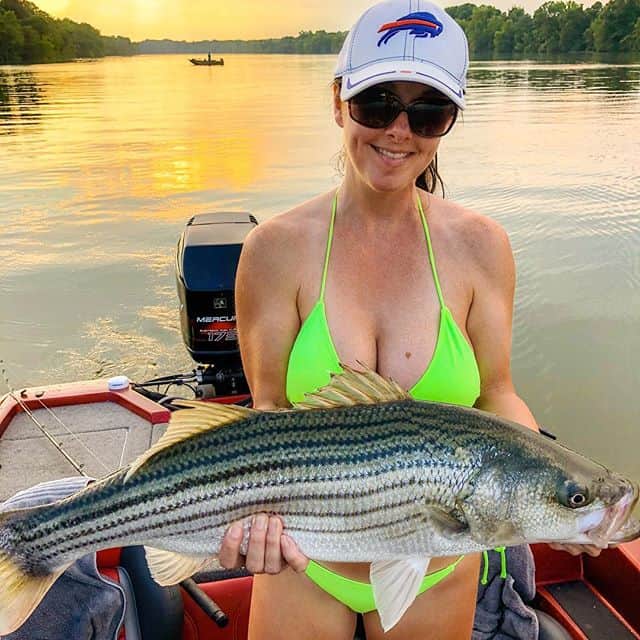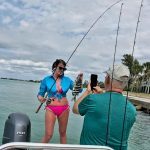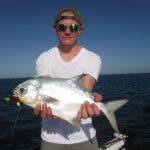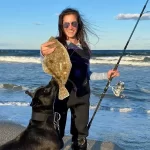Top 6 Live Baits for Freshwater Fishing
This post will list the top 6 live baits for freshwater fishing. While artificial lures catch plenty of fish, many anglers prefer to fish with the real thing. Live bait fishing in freshwater is fairly straightforward. However, there are nuances and tips that will help increase success!
The top 6 live baits for freshwater fishing are;
-
Nightcrawlers and worms
-
Minnows
-
Crayfish
-
Crickets and grasshoppers
-
Leeches
-
Grubs
There are other effective live baits for freshwater fishing. However, these 6 baits are the most common, are readily available, and fairly easy to keep alive. Most of the baits on the list are found throughout North America and will catch just about every species of game fish.

1) Nightcrawlers and worms
The best live bait for freshwater fishing may be nightcrawlers and worms and are first on the list of top 6 live baits for freshwater fishing. There are several reasons for this. Most importantly, nearly every freshwater game fish species that swims will devour them. They are also widely distributed, affordable, and easy to keep alive. These are the reasons why live nightcrawlers and worms the best choice for freshwater anglers fishing with live bait.

Nightcrawlers and worms are very convenient to use as fishing bait. They are widely distributed and are available at just about every freshwater fishing bait store. Several major chains that sell fishing equipment keep them in stock as well. In many areas, they can be purchased at convenience stores and gas stations as well.
check out my post on the best freshwater fishing tackle and lures
Nightcrawlers and worms are fairly easy to keep alive. This is the main reason that they are so widely available to anglers fishing in freshwater rivers and lakes. As long as they are kept cool and slightly damp, worms will live a long time. Most anglers keep them in the refrigerator. Nightcrawlers usually come packaged in some type of dirt or topsoil.

Anglers can certainly catch their own nightcrawlers as well. This is best done in the early evening at night. They will come out after a fresh rain but anglers will also water the lawn just before dark. Then, using a flashlight muted some darker clear paper, angler search for them in freshly cut lawns. These rascals are quick and it does take some practice to learn to capture them! Garden worms are much easier to procure by digging in fertile soil. Compost piles will attract them as well.

Freshwater fishing with nightcrawlers and worms
Nightcrawlers and worms can be hooked in several ways. They can be hooked right through the the front. This allows the bait to swim and undulate very naturally in the water. Many anglers feel that this leaves too much of the bait exposed away from the hook. However, most game fish, especially larger ones, will inhale the entire bait, even a large nightcrawler. This should result in a good hookup.

Anglers bottom fishing for catfish and other species will often thread the nightcrawler on a hook. Since in many instances the bait is in a fixed position, this is an effective technique. Hooking the worm in this fashion allows the juices and sense to dispersed into the water. This will hopefully attract a catfish or other species that feeds on or near the bottom. Anglers using smaller worms will often put several on the hook.
Walleye anglers have been using special harnesses to present nightcrawlers for many years. These come in a variety of designs. All of them are meant to present the nightcrawler in a very slow but natural swimming motion. Most have multiple hooks and some have spinners and other devices to help attract fish. They are used in conjunction with special bottom bouncing sinkers.

Techniques for fishing with live worms
Nightcrawlers and worms can be fished effectively in a wide range of environments. In most instances, the best approach is to hook the nightcrawler as lightly as possible with as little weight as required. This will result in a more natural presentation. Nightcrawlers can be fished under a float, free lined with little or no weight, and fished on the bottom.
Fishing with live worms and nightcrawlers in rivers
Nightcrawlersand worms work very well for anglers fishing in rivers. They will catch a wide variety of species including largemouth and smallmouth bass, pan fish, trout, catfish, walleye, and more. In swift moving streams and rivers, the best approach is to allow the bait to drift naturally with the current. Deeper holes and slower moving areas are usually best. Smallmouth bass and trout will be caught by anglers using nightcrawlers in these faster moving waters.

Many anglers pursue catfish in larger slower moving rivers using nightcrawlers. In this application, most anglers do well by bottom fishing. Some amount of casting weight is needed to both get the bait out far enough from shore as well is keep it on the bottom. Anglers fishing in boats use special sinkers to hold the bottom. Bass and panfish will also be caught in these warmer, slower moving rivers.

Worms are top baits for many panfish species as well. A worm or piece of nightcrawler fished under a float has produced many panfish for anglers over the decades. Most panfish have small mouths. Therefore, a smaller garden worm or red wiggler is the best choice when targeting these diminutive little game fish.
2) Minnows

Big fish eat little fish, it is a basic fact of life. Therefore, live minnows are a fantastic bait used by anglers freshwater fishing all over the world. They are second on the list of top 6 live baits for freshwater fishing. Small minnows are very effective on crappie. Live minnows are by far the top live bait for crappie. Large bluegill and trout will take them as well.
Medium sized minnows will fool smallmouth bass, walleye, larger trout, and a host of other species. Anglers targeting trophy largemouth bass, pike, musky, and other species will use live minnows up to a foot long!

Anglers can either purchase live minnows or catch their own. In areas where they are effective baits, live minnows are available at most bait and tackle shops. Most are commercially raised and fairly easy to keep alive in an aerated bucket or livewell. Bait fish species vary by region and the list is long. However, shops will carry the best minnows for their particular region.
Anglers can catch live minnows in traps or by using seines, cast nets, and dip nets. This can be great sport itself. A minnow trap set in the evening will often catch enough baits for a morning of fishing. Nets and seines can quickly catch a lot of minnows. Anglers in large lakes use cast nets to catch live herring and shad for striped bass and catfish. Anglers should check local fishing regulations before catching live bait fish.

Freshwater fishing with live minnows
Live minnows can be presented in a variety of manners. In shallow water, live minnows are most often fished under a float. This allows anglers to suspend the bait at the desired depth, usually just above the bottom or submerged vegetation or structure. Anglers can hook the minnow through the lips or under the dorsal fin.
Anglers fishing with minnows in freshwater can use them in deep water as well. A minnow lip hooked on a drop shot rig works very well. A bare jig can be used and is very convenient as the hook and weight is combined in one unit. This works very well for anglers ice fishing.

3) Crayfish
Crayfish are a terrific freshwater fishing baits. They are primarily used for bass, particularly smallmouth bass, but will fool most freshwater game fish species. Tiny crayfish are deadly on large bluegill. Catfish and walleye will devour them in rivers.

Crayfish are fairly easy to catch in traps. A trap baited with a chunk of bacon and left overnight in a likely spot should catch a bunch of crayfish. Some bait shops sell them, but crayfish are less available than minnows and worms.
Crayfish love rocks and are often found near them. That is one reason they are such productive baits for smallmouth bass and walleye, which relate to rocky structures as well. Crayfish are especially effective in streams and rivers, which is prime habitat for crayfish.

Crayfish are most often hooked in the tail from the underside. They are drifted in the current in streams and rivers or along rip rap, rocky and gravel points, and submerged rock piles in lakes. They are usually fished with little weight, perhaps just a spilt shot or two if required.
4) Crickets and grasshoppers

Crickets are a bit of a specialty bait. They are mostly used for bluegill and other panfish. Gray crickets are raised commercially and are the species that are available at bait shops that sell them. Many anglers believe that crickets catch the largest bluegill. They are mostly fished in shallow water under a float and are usually hooked under the collar.

Grasshoppers are rarely sold in bait shops. Anglers can catch them in the morning when dew on the vegetation slows them down. They are similar to crickets in the manner in which they are hooked as well as being excellent baits for panfish. Grasshoppers will also catch all species of trout in streams as well.
5) Leeches

Leeches are found throughout North America and the rest of the world. However, they are really only used as fishing bait in the northern states and Canada. They are very enticing in the water as the undulate quite seductively. Walleye and smallmouth bass in particular love them!
Leeches are available at bait shops and even online. They do best in an aerated container, but will live in the refrigerator if the water is changed every day or two. Leeches do not like warm or dirty water.

Most anglers fish leeches on or very close to the bottom. A worm harness or Carolina rig works well. Structure such as channel edges, rockpiles, submerged vegetation, and reefs are top spots to fish a live leech.
6) Grubs and maggots
Grubs and maggots are universally used by anglers ice fishing. They will fool just about every species that can be caught through the ice. Mealworms and wax worms (waxies) are the most popular. Anglers often fish them in conjunction with a jig.They are final on the list of top 6 live baits for freshwater fishing.

Grubs and maggots are readily available at bait shops in ice fishing country. They are also available to order online. Most are fairly easy to keep alive as long as they do not get too warm or too cold. They are also terrific for panfish in open water.
Fishing with live nightcrawlers in lakes
Nightcrawlers certainly work very well in lakes, too. Largemouth bass, smallmouth bass, walleye, catfish, trout, and panfish are the primary species being sought. However, just about every other species that swims will take one.
In shallow water, anglers free line baits near cover. Weed edges, sloping points, docks, bridges, ledges, submerged rock piles, and submerged weed beds are just a few examples of good fish holding cover. Anglers can use a float to suspend the nightcrawler just above the structure. This both reduces snags and gives anglers a visual reference when a fish takes the bait. Anglers fishing for panfish will do well just using a small piece of a nightcrawler on a small hook.

Anglers fishing with nightcrawlers in deeper water will usually choose to use some type of sinker. There are quite a few different designs of fishing sinkers that anglers can use to keep their baits on or near the bottom. This applies to rigs as well. Species such as catfish and sturgeon are found very close to the bottom. Rigs that present the nightcrawler on the bottom will do best.
Slow trolling with a live nightcrawler is an extremely effective technique for walleye and smallmouth bass in deeper portions of lakes. Using special bottom bouncing sinkers, the nightcrawler is hooked on a Lindy Rig or other set up that allows the nightcrawler to swim naturally in the water. Precise boat control keeps the bait right in the strike zone.
Live bait for freshwater fishing; species that will hit a nightcrawler
The list of species that will take a nightcrawler is very long. It includes just about every game fish in North America. There are a few subtle differences in location a presentation that will help anglers catch more fish.
Bass
Both largemouth bass and smallmouth bass will take a live nightcrawler. In fact, the most popular lure for largemouth bass is a plastic worm. There is good reason for this! Too many anglers today overlooked the effectiveness of a live nightcrawler when targeting largemouth bass. However, smallmouth bass anglers are quite familiar with how well these baits work.

A live nightcrawler cast out towards a weed line, dock, rock pile, or other structure in fairly shallow water will catch both largemouth and smallmouth bass. Anglers specifically seeking smallmouth will do well to fish it on a drop shot style rig on submerged rock piles and weed beds in 15 to 30 feet of water.
TROUT

Trout will certainly take a live nightcrawler as it drifts in the current. All of the major trout species, rainbow, brook, brown, and others all feed on worms at one time or another. They can be particularly effective when the water levels are high and stained. In those situations, the scent of a live bait can be the best choice. Generally, slower, deeper pools are the best spots to catch trout on a nightcrawler.
Catfish

Many catfish have been landed over the years by anglers using nightcrawlers for bait. Most often, they are threaded on the hook and fished on the bottom. Anglers seeking trophy catfish will often use several nightcrawlers at once on a large hook. Deeper outside bends in river channels are excellent spots to try. Catfish in lakes will be caught on channel edges and around submerged structure such as fallen timber.
Walleye

Nightcrawlers are a terrific live bait for walleye! Anglers have been using them successfully for many decades. Most often, they are fished on or near the bottom using specially designed harnesses. Both trolling and drifting are effective depending on the prevailing conditions.
Panfish

Nightcrawlers work very well on panfish. They are very economical bait as only a small piece of the worm is needed. This results in a dozen nightcrawlers producing a lot of bluegill, sunfish, shallow cracker, and other species. The piece of nightcrawler can be fished on a small hook with a split shot and allowed to free fall through the water column. Many anglers fish the piece of nightcrawler under a small bomber.
Bonus section; commercial baits

There are also fishing baits that are not live, but are fished much the same way. These are commercially available baits such as Berkley Trout Nuggets. The selection is quite extensive. Gulp! also offers a line of baits that covers just about every freshwater fishing situation. Since many trout are stocked and raised on prepared food, these commercial baits are extremely effective. Panish, catfish, and other species will take these as well.
The primary advantage to using these baits is convenience. It is nice to have them sitting in a jar in the tackle box, ready to use at any time. No need to keep anything alive! The mess is minor as well. They are effective enough to definitely be another option for freshwater anglers fishing with live bait.
In conclusion, this article on the top 6 live baits for freshwater fishing will help anglers achieve more success!






